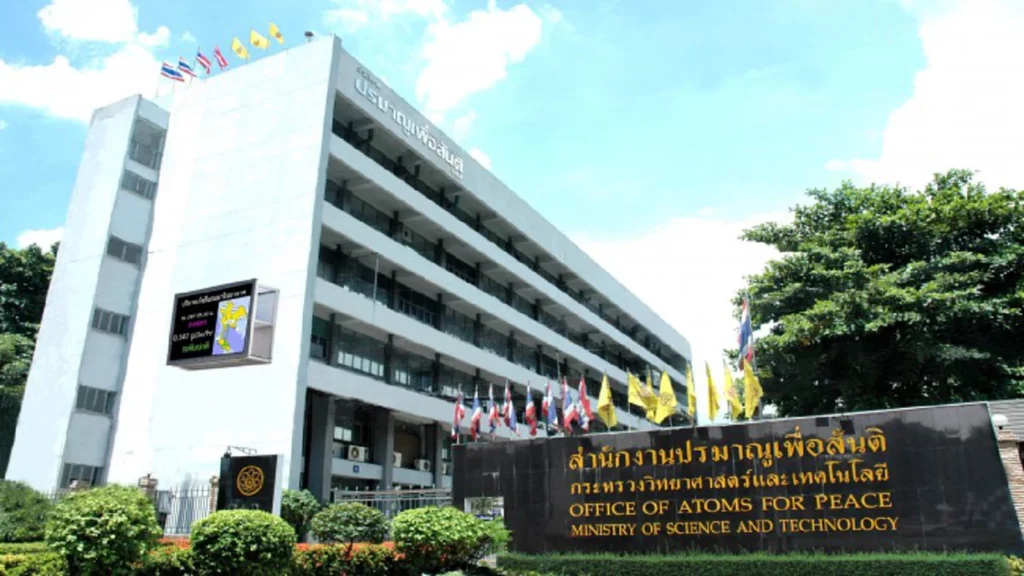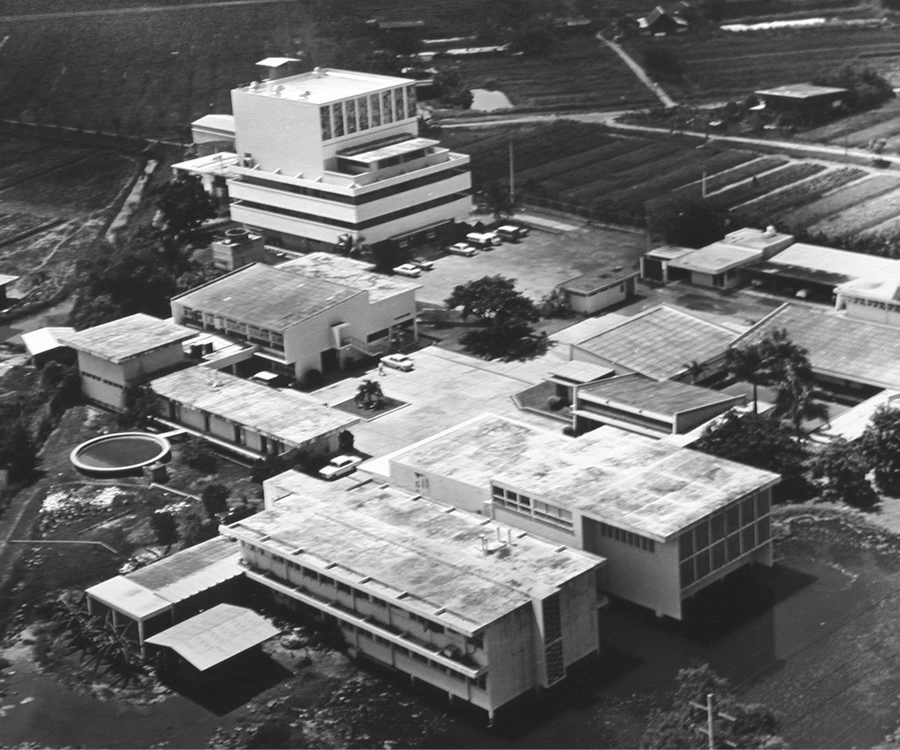Office of Atoms for Peace

On September 23 rd 1954, The United States under President Eisenhower made a statement in the United Nation Assembly to implement the plan to promote peaceful utilization of atomic energy. The U.S. then assigned delegations to various countries around the world including Thailand to seek cooperation and discuss proceeding of the plan.
Royal Government of Thailand through the Cabinet had agreed to appoint a board, consisted of experts in various science-related fields, called “Committee on Atomic Energy” (which has been renamed to “Atomic Energy Commission for Peace, A.E.C” since 1956) on November 17 th 1954 to confer with the Affiliated Atomic Commission of the U.S. Congress on the occasion of their official visit to Thailand. The committee reported the resultant dialogue to the Cabinet on December 7 th 1954. The Cabinet later approved the plan proposed by the committee and assigned the committee to implement the plan as well as establish a nuclear research reactor and laboratory for education, training and research of Thai scientists and engineers pursuing peaceful utilization of atomic energy. The U.S. Government also proposed to provide support through training of Thai scientists as well as to supply equipment and isotopes for medical and science-related applications.
Atomic energy applications in Thailand have then progressed through supports from international communities and the very first group of Thai scientists received their training from Argonne in May 1955.
On 15 October 1957, Royal Thai Government ratified the statue of the International Atomic Energy Agency, IAEA, as an agency under the United Nation and consequently was the th 58 on the list of IAEA Member States

On May 14 th 1958, the Cabinet approved the Thai A.E.C. to issue a contract for the construction of a research reactor building and the reactor from Curtiss-Wright Corporation, USA at the location of Bangkhen, Srirubsook Road (now Vibhavadi-Rangsit Road) on May 20 th, 1960. At that moment the Thai A.E.C.’s temporarily office was at the Department of Science (now Department of Science Service) and run by government personnel who were trained in nuclear engineering or science programs from affiliated agencies.

On April 25 th 1961, Royal Thai Government proclaimed the enactment of the Atomic Energy for Peace Act, B.E. 2504 resulting in the establishment of the Office of Atomic energy for Peace, OAEP, located on Srirubsook Road, Bangkhen, PraNakhon (now 16 Vibhavadi- Rangsit Road, Chatuchak, Bangkok, 10900). In accordance with its statutory functions, OAEP was responsible for undertaking the research and development in nuclear technology for developing the country and regulating on nuclear and radiation safety. Since then OAEP has been under different Ministries as follows:
1961 – 1963: The Office of Prime Minister
1963 – 1972: Ministry of National Development
1972 – 1979: Ministry of Industry
1979 – 1992: Ministry of Science Technology and Energy
1992 – 2002: Ministry of Science Technology and Environment
2002 – 2019 Ministry of Science and Technology
2019 – Current: Ministry of Higher Education, Science, Research and Innovation
The issuance of Government Reorganization Act in 2002, Article 39 and 39(2) to improve efficiency and productivity of governmental section renamed the “Office of Atomic Energy for Peace” to “Office of Atoms for Peace” and the “Secretary General of Office of Atomic Energy for Peace” to “Secretary General of Office of Atoms for Peace.”

The issuance of the Royal Decree Establishing Nuclear Institute of Technology (Public Organization) B.E. 2549 in the Royal Gazette Volume 123 Part 39a dated April 20 th 2006 effective April 21st 2006 and the Cabinet Resolution on November 21 st 2006 on transfer of business, property, authority, liability, and budget involving nuclear research have separated Thailand Nuclear Institute of Technology (Public Organization) from the Office of Atoms for Peace to mainly focus on nuclear research conduction.
Rapid advancement of nuclear technology had outdated the Atomic Energy for Peace Act, B.E. 2504 and its Amendment. Some provisions were neither appropriate nor applicable. It was clearly evident that a comprehensive nuclear law for safety, security and safeguards in line with international standards was needed to protect people and environment from utilization of radiation and nuclear energy in Thailand. As a result, the Nuclear Energy for Peace Act B.E. 2559 had been developed and become effective since February 1, 2017.
Aiming for the Office of Atoms for Peace to support higher regulatory functions under present circumstances, the Ministerial Regulation on Structuring of the Office of Atoms for Peace has been issued and effective since January 24, 2018. The Office of Atoms for Peace is ready to better carry out its functions of a nuclear and radiation regulator in a more effective and efficient manner.
However, the Nuclear Energy for Peace Act, B.E. 2017 provided too rigid regulations on radiation generators that it affected a wide range of stakeholders. The Amendment of the Act was proposed to the National Legislation Assembly to lessen burdens on licensee, and to define more appropriate fines and penalties. As a result, the Nuclear Energy for Peace Act No. 2 B.E. 2019 has been promulgated on April 5, 2019 and become effective since June 4, 2019.
In addition, a year 2019 was considered a very important year for Thailand as it served as ASEAN chair. By this virtue, OAP was duly handed over chairmanship for ASEANTOM (ASEAN Network of Regulatory Bodies on Atomic Energy). As ASEANTOM chair, OAP had a privilege to host the 6th Annual ASEANTOM meeting, bilateral meetings with dialogue partners and other relevant training courses to promote safety, security and safeguards throughout the year. Special attentions were paid to the security of radioactive materials and emergency preparedness and response.
At present, the Office of Atoms for Peace is a major organization responsible for formulating of a national nuclear policy and strategy for peaceful purposes and for regulating the use of radiation and nuclear energy in the country for safety of users, people and environment according to international standards and obligations.